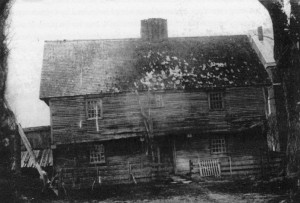Queen Anne’s War (1702-1713)
In Europe, this conflict was known as the “War of the Spanish Succession,” and was, as the name suggests a balance of power struggle between England (and others) vs. France and Spain. The North American theatre of operations had expanded with both French and Spanish territories involved vs. the English. In the northeast, it took the form of continued raids and counterattacks.

Northeastern United States in the Early 18th Century
The borders between New France and the northeastern English colonies were not well defined, were thinly settled and formed the main location of conflict.
The English and French had very different approaches to colonization. New France was initially populated by single men under the direct control of the King and was focused on the fur trade and converting the Indians. Soldiers and roving fur traders still formed a high % of the population. The smaller French population was very thinly spread – mostly along the St. Lawrence.
Although less organized than the more militarized French, the English colonial population had grown remarkably and was about 250,000 by the beginning of the 18th century. They lived towns in New England and larger plantations in New York and the South. One consequence was that the New England colonies presented more “soft targets.”
The French and the English each had Indian alliances and used the Indians as mercenaries. Although the raids were fairly isolated they spread the kind of fear terrorists do today. Between the fierceness of these mercenaries, the competition for the northeastern fur trade, and the growing population imbalance, the French and English colonies were beginning, with Queen Anne’s War, to seek opportunities to permanently control the continent.
Deerfield Destroyed

The most famous New England event in this war was the February 29, 1704 raid on Deerfield.
Called the Deerfield Massacre, the raid was typical of all of the 18th century raids on New England in that it was led by a French officer, Jean Baptiste Hertel de Rouville, but primarily carried out by up to 300 Indians from a variety of nearby tribes. (some of whom had formerly occupied the land purchased -at a very low price- by the English. These enemies would raid and then disperse.
Nonetheless, the fear was warranted. Despite a timely warning that allowed many of the town’s residents to gather in a fortified home, 40% of the village houses were destroyed, 56 villagers were killed and 109 were taken captive. The captives were forced to trek (in February) to an Indian camp outside of modern-day Montreal.
This was the second time Deerfield had been raided – see “King Phillip’s War.”As you might imagine, word of this the horror of this horrendous experience spread far and wide and mightily discouraged settlement in areas that would be difficult to defend.
From Florida to Hudson’s Bay
Since the Spanish were also involved in this war and English colonists from Carolina attacked Florida. They did not succeed in capturing the Spanish territory, but did manage to destroy most of the Indian population and wipe out the Spanish mission system in Florida.
The English colonies of New England fought with French and Indian forces based in Acadia and Canada. Quebec City was repeatedly targeted (but never successfully reached) by British expeditions, and the Acadian capital Port Royal was taken in 1710.
The French and Wabanaki Confederacy sought to thwart New England expansion into Acadia, whose border New France defined as the Kennebec River in southern Maine.
On Newfoundland, English colonists based at St. John’s disputed control of the island with the French based at Plaisance. Most of the conflict consisted of economically destructive raids against the other side’s settlements. The French successfully captured St. John’s in 1709, but the British quickly reoccupied it after the French abandoned it.
Following a preliminary peace in 1712, the Treaty of Utrecht ended the war in 1713. It resulted in the French cession of claims to the territories of Hudson Bay, Acadia, and Newfoundland to Britain, while retaining Cape Breton and other islands in the Gulf of St. Lawrence. Some of its terms were ambiguous, and concerns of various Indian tribes were not included in the treaty, setting the stage for future conflicts
What Did This Mean for Those Who Would Eventually Settle Lenox?
The burden of this war fell primarily on New England so it is possible some of our town founders’ grandfathers would have been involved in the numerous attempts to take Quebec or in capturing Acadia.
Massachusetts broke the bank on the costs of this war (and it wasn’t the last time). Soldiers and suppliers were paid in paper money that had little value. This may have hampered the families trying to finance expansion to new towns in Massachusetts. Nonetheless between the British troops that eventually participated and the outfitting of war vessels, the overall impact on the merchant economy was probably positive.
The most important impact was the fear of raids that continued to shape the pattern of settlement. Although our town founders’ grandparents probably would have moved on from the coast by this time, they would have been inclined to stay close to existing towns and avoid northern or western Massachusetts. Hence, most of our town founders came from settlements along the southern Connecticut River.
See Wikipedia, A Few Acres of Snow by Robert Leckie and The First Frontier by Scott Weidensaul